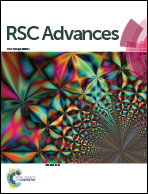Alkali metal decorated C60 fullerenes as promising materials for delivery of the 5-fluorouracil anticancer drug: a DFT approach†
Abstract
The development of effective drug delivery vehicles is essential for the targeted administration and/or controlled release of drugs. Using first-principles calculations, the potential of alkali metal (AM = Li, Na, and K) decorated C60 fullerenes for delivery of 5-fluorouracil (5FU) is explored. The adsorption energies of the 5FU on a single AM atom decorated C60 are −19.33, −16.58, and −14.07 kcal mol−1 for AM = Li, Na, and K, respectively. The results, on the other hand, show that up to 12 Li and 6 Na or K atoms can be anchored on the exterior surface of the C60 fullerene simultaneously, each of which can interact with a 5FU molecule. Because of the moderate adsorption energies and charge-transfer values, the 5FU can be simply separated from the fullerene at ambient temperature. Furthermore, the results show that the 5FU may be easily protonated in the target cancerous tissues, which facilitates the release of the drug from the fullerene. The inclusion of solvent effects tends to decrease the 5FU adsorption energies in all 5FU-fullerene complexes. This is the first report on the high capability of AM decorated fullerenes for delivery of multiple 5FU molecules utilizing a C60 host molecule.



 Please wait while we load your content...
Please wait while we load your content...